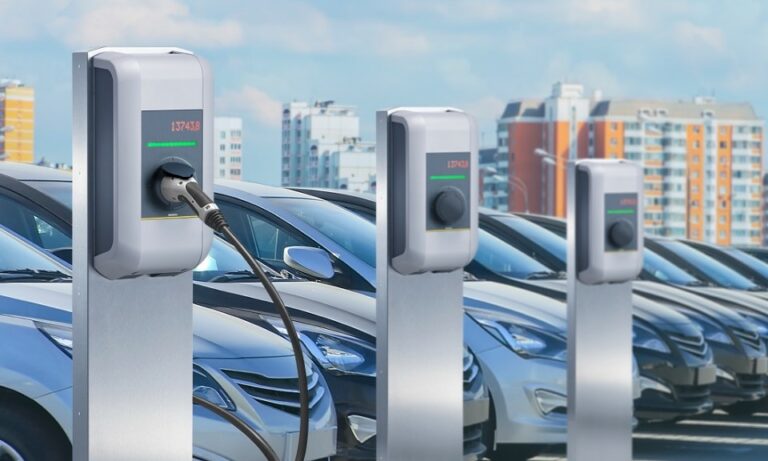APT Skidata’s managing director Steve Murphy discusses how retail destinations can take advantage of the rise in electric vehicle ownership
Devising your approach to introducing EV charging technology – and managing it once you have it – can be tricky. It can be difficult to know where to start and since the landscape is constantly evolving, and so too is the potential demand for EV charging in public places, meaning what might be right for a site today may not be right for it tomorrow.
Steve Murphy, managing director at APT Skidata says there are very sound reasons why you should add EV charging to your car parks, and advises continual assessment of what you are offering to see how you should expand it in line with growing demand from the increasing number of EV drivers.
The inclusion of EV charging within a car park provides, says Murphy, not only convenience for customers who can charge while they park but can also attract new customers and how much you yield from car park tariffs: “Establishing your drivers needs and deciding how you want your drivers to interact with the EV charging, the car park, the local service or the shops is essential. The retail landscape has changed over the past two years beyond all recognition. What actions you take with your EV charging solution will again change that retail experience.”
Once a decision has been made as to how you want your drivers to interact with your car park and EV charging, the next thing to consider it how it is managed. Murphy says that sometimes it is good to have multiple suppliers, but for many it may be easier to have one with one shared database and one tool to manage everything – the overall deciding factor will likely be the cost of the operation it will impact the ability to make revenue on EV charging.
When considering starting out on the process of installing EV charge points, Murphy suggests beginning by assessing the opportunity: “It is important to understand your site and consider the best area within the car park to start with, taking into account groundwork and electricity supply location along with accessibility, shopper footfall and employee parking. You don’t have to have all the answers yourself – this would be a good time to bring in a partner to help you assess the opportunity.”
He says that you will also want to start looking at the most appropriate technology to install and suppliers to work with, and that while there are a growing number of options available the most important part to remember is that from a customer experience standpoint the charge points should be as easy to use: “The best user experience by far is for EV drivers to pay for their parking and their charging in one simple transaction at your standard pay machine or on exit, making it as seamless as possible for them. It pays to seek out a charging solution that integrates with our parking system.”
He also suggests that, in order to protect the investment and to keep customers happy, the charge points should be reliable, meaning they should be regularly maintained to minimise the risk of them being out of action, and suggests thinking about what support the car park team can provide to help customers who may be having any issues with the charging process.
As a parking specialist, Murphy says that APT Skidata has seen car park operators and owners grapple with the new challenges that arise once charging infrastructure has been installed and that often the root cause of this is that the EV charging is not integrated with the car park management system.
“They can’t easily track customer usage patterns and they don’t know what tariffs to set and can’t implement the flexible pricing which they know will keep customers coming back,” he tells. “Data is incredibly important not just to help you strip out this confusion today but because it gives you the insight for what to do going forward and this is why our new EV charging solution seamlessly integrates with APT Skidata’s Parking.Logic car park management platform.”
When it comes to choosing the right type of charge point, Murphy says it will largely be down to the dwell time of the EV driver and the energy capacity of the site. For shoppers visiting for an hour or two, he suggests a 22kW chargers as it gives good cost efficiencies and future proofing for new cars and batteries that will be coming onto the market in the coming year. However, he says 7kW charging can also be sufficient especially if you can accommodate longer dwell times and are looking at low investment to start with.
The key thing to remember, he says, is to start small and scale up: “You could start with changing just four or eight standard spaces initially and considering the rising number of EVs on UK roads you can expect this figure to be 40-50% of your spaces by 2030. What will be important is having the right data and intelligence from your car park management system to show the utilisation and guide you as you scale up the charging provision.”
The point, he adds, is that you need to start somewhere are not get left behind: “The demand for EVs and chargers has surged in recent years, with a 66% increase in the number of EVs on the road since 2019. While there has been a rise in the number of public EV chargers, with 22,000 available, the number is limited when you compare it to the one million EVs on the road, resulting in a ratio of one charger per 43 EVs. And with EV charging being the most obvious ‘bolt on’ service within a car park, retail destinations find themselves in a perfect position to support greener motoring.”
This was first published in Retail Destination Fortnightly. Click here to subscribe.


